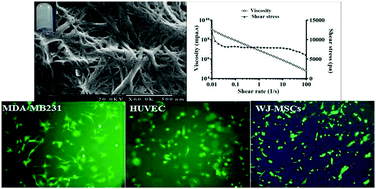Structural, mechanical, and biological characterization of hierarchical nanofibrous Fmoc-phenylalanine-valine hydrogels for 3D culture of differentiated and mesenchymal stem cells†
Abstract
Fmoc-dipeptides are a class of short aromatic peptides featuring eminent supramolecular self-assembly, which is due to the aromaticity of the Fmoc group, which improves the association of peptide building blocks. This study aimed to introduce a new dipeptide hydrogel scaffold, Fmoc-phenylalanine-valine (Fmoc-FV), for 3D culture of various cells. Peptide hydrogel scaffolds were prepared by the pH-titration method in various concentrations and temperatures, and characterized by spectroscopic methods, including circular dichroism, attenuated total reflection FT-IR and fluorimetry. Mechanical behaviors such as thixotropy and temperature-sensitivity were investigated by oscillatory rheology. The Fmoc-FV hydrogels were then applied in 3D-culture of WJ-MSCs (mesenchymal stem cells), HUVECs (normal endothelial cells), and MDA-MB231 (tumor cell line) by live-dead fluorescence microscopy and Alamar blue viability assay experiments. The results confirmed that the β-sheet structure is principally interlocked by π–π stacking of the Fmoc groups and entangled nanofibrous morphologies as revealed by FE-SEM. Fmoc-FV self-assembly in physiologic conditions resulted in a thermo-sensitive and shear-thinning hydrogel. Notably, the Fmoc-FV hydrogel exhibited cell type-dependent biological activity, so higher cell proliferation was attained in HUVEC or MDA-MB231 cells than WJ-MSCs, indicating a possible need for incorporating cell-adhesion ligands in the Fmoc-FV hydrogel matrix. Therefore, the structural and biological properties of the Fmoc-dipeptide hydrogels are inter-related and can affect their applications in 3D cell culture and regenerative medicine.



 Please wait while we load your content...
Please wait while we load your content...